
"It's the same at virtually every wedding I attend. Friends and family sit at tables throughout the reception tent, sipping wine and snacking on duck confit while the red-hot band on stage blasts out a festive wedding playlist. As darkness falls outside the tent, guests begin to migrate two by two from their tables to the dance floor until just about everyone in attendance is out there pounding the parquet to the beat of the band."
"We're talking nostalgia, of course, triggered by hearing a song that was popular way back when they were in high school. But why should a 47-year-old song make them want to shake their groove thing when "Uptown Funk," which is arguably funkier than "September," leaves them in their seats. A recent study at Western University in London in Ontario, Canada, explored this question and shed some light on the unique power of nostalgia to get us out on the dance floor."
Familiarity with a song increases the urge to move, but nostalgia produces an even stronger impulse to dance. Hearing songs linked to personal pasts can pull listeners from passive enjoyment to active movement, as shown by examples like older guests dancing to "September" despite enjoying contemporary covers. Intrinsic musical qualities—tempo, rhythm, melody—also influence groove and movement. A study at Western University examined whether nostalgia makes people more likely to move than familiarity alone and found that nostalgic resonance uniquely motivates bodily movement beyond mere recognition or liking of a song.
Read at Psychology Today
Unable to calculate read time
Collection
[
|
...
]